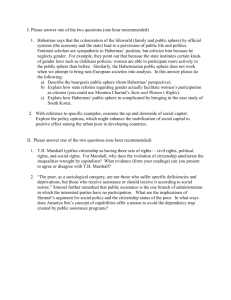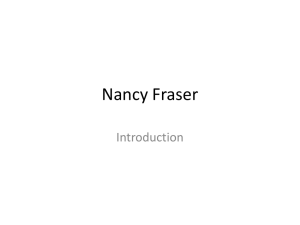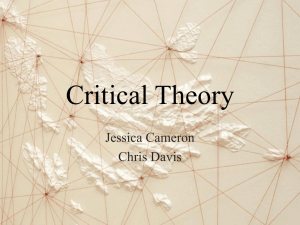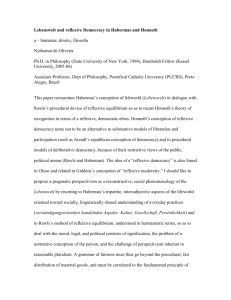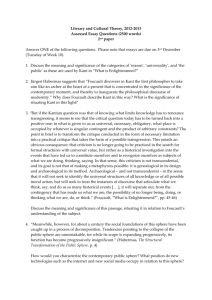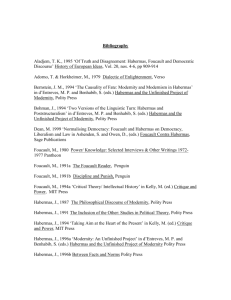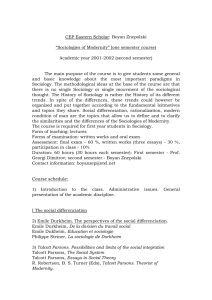Jurgen Habermas & Nancy Fraser: The Reinvention of Critical Theory
advertisement
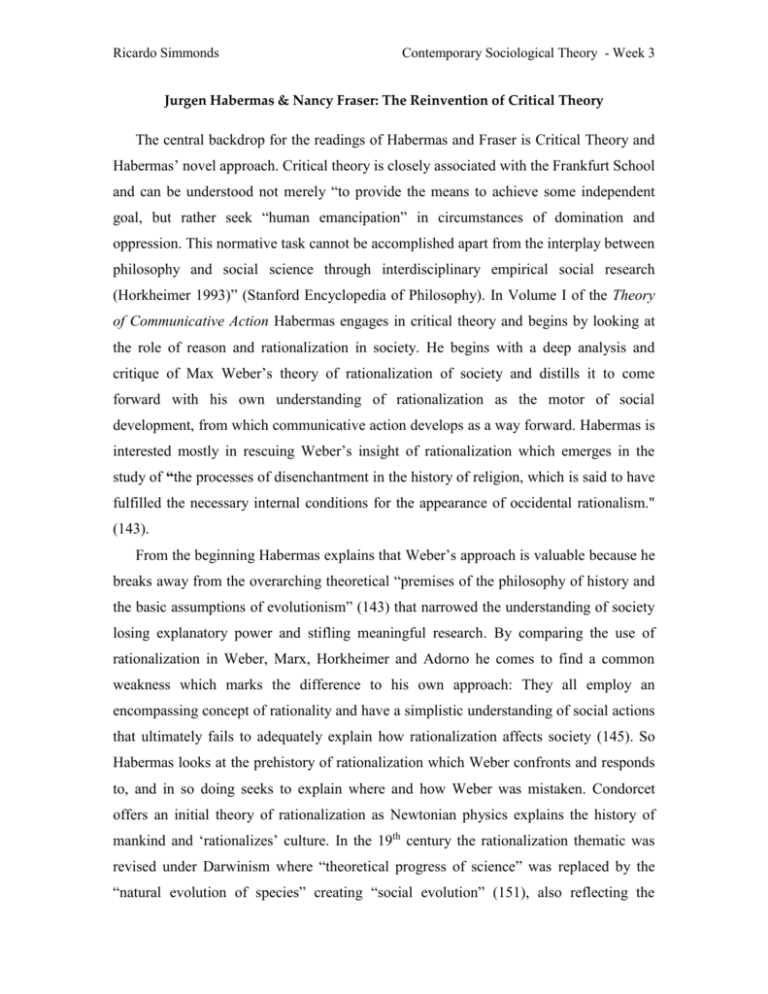
Ricardo Simmonds Contemporary Sociological Theory - Week 3 Jurgen Habermas & Nancy Fraser: The Reinvention of Critical Theory The central backdrop for the readings of Habermas and Fraser is Critical Theory and Habermas’ novel approach. Critical theory is closely associated with the Frankfurt School and can be understood not merely “to provide the means to achieve some independent goal, but rather seek “human emancipation” in circumstances of domination and oppression. This normative task cannot be accomplished apart from the interplay between philosophy and social science through interdisciplinary empirical social research (Horkheimer 1993)” (Stanford Encyclopedia of Philosophy). In Volume I of the Theory of Communicative Action Habermas engages in critical theory and begins by looking at the role of reason and rationalization in society. He begins with a deep analysis and critique of Max Weber’s theory of rationalization of society and distills it to come forward with his own understanding of rationalization as the motor of social development, from which communicative action develops as a way forward. Habermas is interested mostly in rescuing Weber’s insight of rationalization which emerges in the study of “the processes of disenchantment in the history of religion, which is said to have fulfilled the necessary internal conditions for the appearance of occidental rationalism." (143). From the beginning Habermas explains that Weber’s approach is valuable because he breaks away from the overarching theoretical “premises of the philosophy of history and the basic assumptions of evolutionism” (143) that narrowed the understanding of society losing explanatory power and stifling meaningful research. By comparing the use of rationalization in Weber, Marx, Horkheimer and Adorno he comes to find a common weakness which marks the difference to his own approach: They all employ an encompassing concept of rationality and have a simplistic understanding of social actions that ultimately fails to adequately explain how rationalization affects society (145). So Habermas looks at the prehistory of rationalization which Weber confronts and responds to, and in so doing seeks to explain where and how Weber was mistaken. Condorcet offers an initial theory of rationalization as Newtonian physics explains the history of mankind and ‘rationalizes’ culture. In the 19th century the rationalization thematic was revised under Darwinism where “theoretical progress of science” was replaced by the “natural evolution of species” creating “social evolution” (151), also reflecting the Ricardo Simmonds Contemporary Sociological Theory - Week 3 historical change in philosophical undercurrents of the time, from positivism to empiricism. Weber’s rejection of four predominant premises that emerge from this context (evolutionary determinism, ethical naturalism, universalism and rationalism) allow for a new sociological approach to rationalization. As Weber develops his theory of rationalization ‘liberated’ from the aforementioned constraints, Habermas analyzes his different concepts of rationality and how they explain his theory of religious and societal rationalization, in order to distill his own structural model of rationalization (156). In short, for Weber an important aspect of rationalization takes place as action is rationalized since unthinking customs and traditions (in the religious sphere mostly) are replaced by conscious rational decisions based on self interest which result in “purposive rational action”. This explains the disenchantment of the religious world and consequently its spill over into society. While Habermas embraces the inner intuition of Weber’s project, he thinks that its conclusions are blinded by its narrow specificity to the Protestant context. Rationalization can be much broader and take different directions if understood more broadly. This is a similar mistake made by the first generation of critical theory which has a generalist explanation of how reason in modernity becomes instrumental reason driven by self interest and thus ultimately opposed to freedom, where liberalism becomes delegitimized and loses normative power. Habermas, under the prism of rationalization as the motor of social evolution, dissected Weber’s and others (Marx, Adorno and Horkheimer) approaches and identified their narrow understanding of reason which sets them up to a consequently limited explanation of modernity. This critique gives Habermas a platform from which to propose a new explanation of modernity based on a more nuanced, and positive, understanding of reason. Habermas seems to find in reason and rationality a positive means of deliberation, communication and solidarity with which he can develop concepts of democracy, law, art, capitalism etc. which are ignored in Weber – all with an undercurrent of hope (“un-stated” for sure) lacking in first generation critical theory. This critique of Weber sets Habermas up for a new ‘project’ of critical theory. The “Three Normative Models of Democracy,” 10 years after the publishing of Theory of Communicative Action, are an expression of this project, where Habermas applies critical theory in a renewed version to the question of democracy. Habermas Ricardo Simmonds Contemporary Sociological Theory - Week 3 begins by contrasting liberal (Lockean) and republican views of democracy by their definitions, corresponding view of citizens and the nature of their political process. In summary, Habermas explains that the liberal view of democracy sees politics as a mediating function that collects and pushes private interests on the government administration as if programming it for societies’ collective interests. This rests on a view that identifies a tension between the administrative power of government versus personal interests regulated by the market which lends itself to a conception of the citizen as bearing negative rights in relation to the government and other citizens. Political authority is a given that guarantees the individual rights as long as the individual lies within the rules established by a higher “reason” that has determined these individual rights. This finally also explains the nature of the liberal political process where within this framework a market of competing preferences is the model through which collectivities seek power through voting preferences. The republican view is quite different. Politics is seen as the constitutive process of society where citizens engage in opinion and will formation. Here solidarity emerges as a third form of social integration beyond the state and the market, having genetic and normative priority over the other two and strategically guaranteeing the assimilation of public opinion into state and market. Thus the republican view stresses positive liberties where the citizens participate in common action, are politically autonomous authors and authority arises from the citizen’s power that institutionalize public liberty. The subjective rights are grounded on a self constituted will and public communication seeks mutual understanding through dialogue, not the market. For Habermas, the republican model preserves the original meaning of democracy since through its trust in political discourse it is the citizens who shape it, also granting democracy a legitimating force and normative function. The liberal view betrays skepticism towards reason and employs the market and its competition for power as the deliberating venue where consequently the public use of reason loses its legitimating power. Next Habermas identifies a common mistake of contemporary republicans to confuse this public communication with a communitarian approach that seeks to explain its existence, collective identity and ethical sense of self. This Habermas calls the “ethical constriction of political discourse” which sees “a necessary connection between the Ricardo Simmonds Contemporary Sociological Theory - Week 3 deliberative concept of democracy and the reference to a concrete, substantively integrated ethical community” (4). This makes democracy hinge on an ethical integrated collective unity – a recipe for failure in a pluralistic society. Not that these ethics of self understanding are questions outside of politics, but rather that they do not hold a necessary primacy in the political realm and are not suited to the legislative process. Habermas solves this by invoking a hierarchy where ethical questions are subordinate to moral questions (in the Kantian sense of questions of justice) which a rooted in universal moral norms beyond the legal community itself. In the framework of a law formed under criteria of universal justice there is room for a “multiplicity of communicative forms” (5) which can include the ethical form, but amidst other forms as well. Conceptually this sounds great but it takes for granted Kant’s ethics and epistemology. This ‘neat’ solution allows Habermas to connect a democratically elected government to the bedrock of universal principles and dismiss ethical issues, understood as those that relate to culture, self understanding, meaning, etc, as somewhat less important. Let’s take as an example the case in Germany of the appeal of Muslim women to be able to have official ID pictures (any head cover in these cases is forbidden) taken with a burka. Strictly speaking this is an example where a question of ethical self understanding (ethics of burka use) conflicts with a universal moral principal (self protection - the ability of the state to protect its citizens - which implies legal identification according to certain standards). This seems to me to be an unresolved issue, which indeed Habermas continues to deal with in his later work (Between naturalism and religion 2008 for example) and is still unsatisfactory, I think. Finally Habermas indentifies a state centrism in both the liberal view of the state as guardian of the market society or in the republican view as an 'instituionalizer' of the ethic community. His own approach suggests a key difference based on a decentered view of the state and society. Similarly, the republican model relies on a social whole for a collective process of opinion and will formation, while the liberal model relies on a mechanical view of the whole regulated by a constitution to regulate the interplay of powers (8). Discourse theory synthesizes both by relying on a decentered society where will and opinion formation are at the centre but also relying on the constitution to institutionalize corresponding procedures for communication. Discarding the philosophy Ricardo Simmonds Contemporary Sociological Theory - Week 3 of consciousness that leads to collective holism or private individualism, discourse theory’s reliance on “higher-level intersubjectivity of communication processes” (8) applies to both formal parliamentary venues as well as the informal public sphere. Thus public will formation still drives the democratic process being normatively stronger than the liberal model, but does so in a decentered and more indirect way (albeit realistic and accounting for ethical pluralism) than the republican model being normatively weaker. The ‘unrealism’ of the republican view is this idealized vision of a collectivity which embodies popular sovereignty where the ‘people’ suddenly replace the one absolute monarch. Nonetheless, Habermas wants also to avoid the stress on individualism of the liberal model that sees autonomous individuals as functioning mechanically within a political structure. Thus he places his approach in between the two, a realistic democracy yet still legitimated by the people. This finally has consequences for the three sources of democratic integration (economy, administrative power and solidarity) since society infuses the other two through these decentered public spheres, not as a whole. To conclude, Habermas interestingly turns to one implication on legitimation by returning to the idea of rationalization. While only the administration can act, it is public opinion which constitutes primarily the rationalization of decisions that drive the democratic community. Finally, in Fraser we see a critique of Habermas’ approach to the public sphere. Here too we see an alternative explanation of political reality and consequentially its deligitimization. With a new explanation and reconstruction by Fraser she grants a renewed normativity to the public sphere and by consequence democracy that ‘relies’ on it. Fraser considers Habermas’ account of the public sphere to be exclusive on the basis of gender and class. Rather than being a vehicle for public participation the public sphere as Habermas’ paints it promotes partial ideals of sexism, classism and private/public distinctions characteristic of a male dominated bourgeois elite. There was not one harmonious public sphere where differences were bracketed to conjure the political will of the people but many other marginalized publics (such as American women, peasants etc.) which were in conflict among each other. Thus the public sphere as presented by Habermas’ rather acted as a vehicle for political domination through the construction of consent (62). The public sphere is thus deconstructed as “bourgeois masculinist” which Ricardo Simmonds Contemporary Sociological Theory - Week 3 bears 4 assumptions: societal equality is not necessary for democracy, a single public sphere is preferable to multiple publics, private issues and interests as opposed to common good deliberation are undesirable and that public spheres require a sharp separation between civil society and state. In response to the first and second assumptions Frasier proposes a plurality of public spheres under egalitarian conditions, or subaltern counterpublics, where the public sphere becomes the “structured setting of deliberation among many publics” (69). Even in an egalitarian (classless) but multi cultural society the vision of the plural public sphere is ideal, and that in principle discourse across cultures can be achieved. As for the third assumption, Fraser shows how the common good under the guise of public concern in fact leaves out ‘private’ concerns of a voiceless minority (i.e. women) making the common good suspicious since it is formed by the powerful. The definition of the public thus relegates matters of economy and sex to the private sphere and away from political discourse, and is therefore oppressive. Finally, Fraser responds to the fourth assumption by suggesting that Habermas weakness the public sphere by making it too distant from the state and unable to participate in decision making. This weak public can be replaced by strong publics such as parliamentary systems or self governed public institutions (such as self-managed work-places, child care centers, or residential communities) and other “hybrid forms” which include decision making in public sphere processes. 1. 2. 3. 4. How convinced are you of Habermas’ revised theory of rationalization as the motor for social development? Is it sufficiently distinct and more complex and nuanced from Weber, Marx, Hockheimer or Adorno’s? Consider Fraser’s critique of Habermas and his own lack of complexity and nuance. Critical theory rests on the premise that there is a connection between the explanatory and the normative. Fraser dismisses Habermas on these grounds: “The bourgeois conception of the public sphere, therefore, is not adequate for contemporary critical theory” (76), as Habermas seems to dismiss his predecessors on explanatory grounds. Connected to democracy, critical theory tries license normativity based on its explanatory power. Is critical theory itself convincing? What is more naïve: Habermas monolithic understanding of the one public sphere where differences are bracketed or Fraser’s multicultural “kumbaya” of inter cultural diversity and understanding? How close is Fraser’s suggestion influenced (blinded) by American “melting pot” multi-cultural ideology and Habermas challenged by, for example, Angela Merkel’s statements about the failure of the German multicultural project? The example of burka use in Germany is used by Habermas in 2008 and he interestingly sides with the state’s acceptance of the burka use: by invoking the higher moral sense of justice which recognizes freedom and equality of expression, a Ricardo Simmonds 5. Contemporary Sociological Theory - Week 3 universal law. In this way Habermas ‘claims’ to be consistent with his Kantian theory which distinguishes ethics and morals; but is Kantian morality consistent in itself? Religions pose a challenge to Habermas’ solution because they carry a world view in themselves that challenges the Kantian conception at its roots. Religion seen for what it is, “from the inside”, will reveal that a Muslim wears a burka, or a Catholic doctor abstains from performing abortion, etc. not because democracy concedes it on appeals to abstract reasoned universal moral laws but because they actually think it is morally right, true and good as understood from The Truth, God. In this sense Kant moralizes and rationalizes God (the universal, absolute); so why should democracy rest on the god of Kant rather than on the God of Allah, Christ, Moses or anyone else’s for that matter? In the discussion of weak and strong publics Fraser raises the point of the trade off between opinion formation and decision making aspects of the public sphere. Does Habermas’ distinction between the state and public sphere along lines of decision making (acting) indeed make it weak, and thus democracy loses legitimacy and normative power? Again we see the tension between explanatory and normative power.
